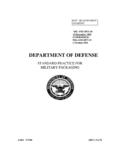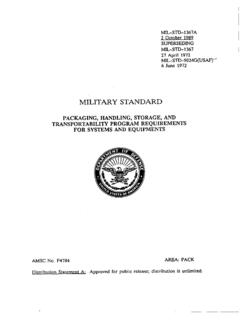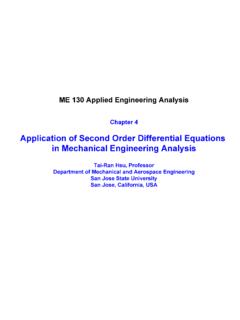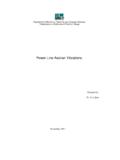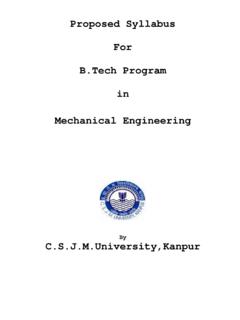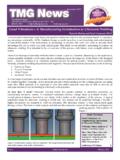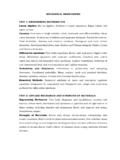Transcription of MIL-STD-167-1, Mechanical Vibrations of …
1 INCH-POUND. MIL-STD-167-1A. 2 November 2005. SUPERSEDING. MIL-STD-167-1(SHIPS). 1 May 1974. DEPARTMENT OF DEFENSE. TEST METHOD STANDARD. Mechanical Vibrations OF. SHIPBOARD EQUIPMENT. (TYPE I ENVIRONMENTAL AND. TYPE II INTERNALLY EXCITED). AMSC 7651 AREA ENVR. DISTRIBUTION STATEMENT A. Approved for public release; distribution is unlimited. MIL-STD-167-1A. FOREWORD. 1. This standard is approved for use by the Naval Sea Systems Command, Department of the Navy, and is available for use by all Departments and Agencies of the Department of Defense.
2 2. This standard establishes requirements and acceptance criteria for: a. Environmental vibration testing of shipboard equipment. b. Balancing shipboard rotating equipment subjected to internally induced vibration during operation. 3. Shipboard equipment that conforms to the requirements of MIL-STD-167-1A is found to satisfactorily perform its functions aboard ship. Equipment for which compliance with MIL-STD-167-1A is not specified or is waived could experience failures induced by vibration in shipboard service.
3 4. MIL-STD-167-1A, environmental vibration testing, and MIL-S-901D, equipment shock testing, provide complementary requirements for the survivability of shipboard equipment. 5. This specification was revised to address the following: a. Requirements for test instrumentation and testing machines. b. Guidance in the selection of response prominences for endurance testing. c. Revisions to requirements for applicable frequency ranges. d. Revisions to attachment methods for equipment. e. Updated for conformance with MIL-STD-962D, Defense Standards Format and Content.
4 6. Comments, suggestions, or questions on this document should be addressed to Commander, Naval Sea Systems Command, ATTN: SEA 05Q, 1333 Isaac Hull Avenue, SE, Stop 5160, Washington Navy Yard DC 20376- 5160 or emailed to with the subject line Document Comment . Since contact information can change, you may want to verify the currency of this address information using the ASSIST Online database at i MIL-STD-167-1A. CONTENTS. PARAGRAPH PAGE. 1. Scope ..1. Applicability ..1. Classification ..1. 2. APPLICABLE General.
5 1. Government documents ..1. Specifications, standards, and Order of 3. Acceptance authority ..1. Amplitude, Amplitude, vibratory Balancing, Balancing, single-plane (static)..2. Balancing, two-plane (dynamic)..2. Critical speed ..2. Environmental vibration ..2. Grade, balance quality ..2. Internally excited Isolation mount ..2. Mass Maximum design Method of correction ..2. Plane, correction ..2. Plane, Residual unbalance ..3. Response prominence ..3. Rotor, Rotor, rigid ..3. Simple harmonic Test fixture Transmissibility.
6 3. 4. GENERAL REQUIREMENTS ..3. Notification of tests ..3. Identification of component compliance ..3. Disposition of tested equipment ..3. 5. DETAILED Type I environmental vibration ..4. ii MIL-STD-167-1A. PARAGRAPH PAGE. Basis of Test Testing Additional test Methods of attachment ..5. Shipboard equipment ..5. Shipboard portable and test Orientation for vibration Isolation mountings ..5. Internal isolation or shock vibration Equipment Exploratory vibration test ..6. Variable frequency test ..6. Exception.
7 6. Alternative test amplitudes ..6. Endurance Endurance test for mast mounted Test Test plan ..7. Test Extension of previous Extension Type II internally excited vibration ..8. Basis of Balance procedure for rigid rotors ..8. Balancing methods for rigid rotors ..8. Balance limits for rigid Balance procedure for flexible rotors ..9. Balance limits for flexible rotors ..9. vibration test procedure ..9. Mounting ..9. Measurements ..9. Instruments ..9. 6. Intended Acquisition Associated Data Item Descriptions (DIDs).
8 11. Tailoring guidance for contractual application ..11. Superseding Subject term (key word) listing ..11. Changes from previous issue ..11. Guidance iii MIL-STD-167-1A. TABLES PAGE. I. Vibratory displacement of environmental II. Duration of endurance test in a given orthogonal direction at each test III. Vibratory displacement of environmental vibration for mast mounted equipment ..7. IV. Types of balancing ..8. FIGURES PAGE. 1. Type I environmental vibration limits (black bars represent a graphical presentation of table I expressed in displacement, velocity, and acceleration).
9 13. 2. vibration acceptance criteria for Type II vibration ..14. 3. Minimum static deflection of mounting for Type II vibration test ..15. Appendix Scope ..16. Determining and displaying transmissibility ..16. Transmissibility magnitudes ..16. Transmissibility and Identifying response prominences ..16. Selecting endurance test frequencies ..17. Non-response prominence frequencies where functional or structural integrity is affected ..17. Frequencies where response prominences have been identified ..17. Guidance for specifiers.
10 18. iv MIL-STD-167-1A. 1. SCOPE. Scope. This standard specifies procedures and establishes requirements for environmental and internally excited vibration testing of Naval shipboard equipment installed on ships with conventionally shafted propulsion (see and ). Applicability. The test methods specified herein are applicable to shipboard equipment subjected to Mechanical Vibrations from the environment and from internal excitation caused by unbalanced rotating components of Naval shipboard equipment. For those Mechanical Vibrations associated with reciprocating machinery and lateral and longitudinal Vibrations of propulsion system and shafting, see MIL-STD-167-2.

